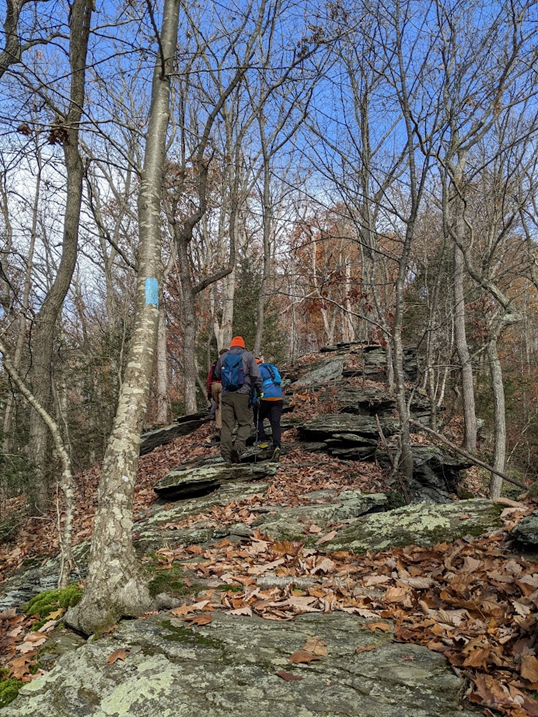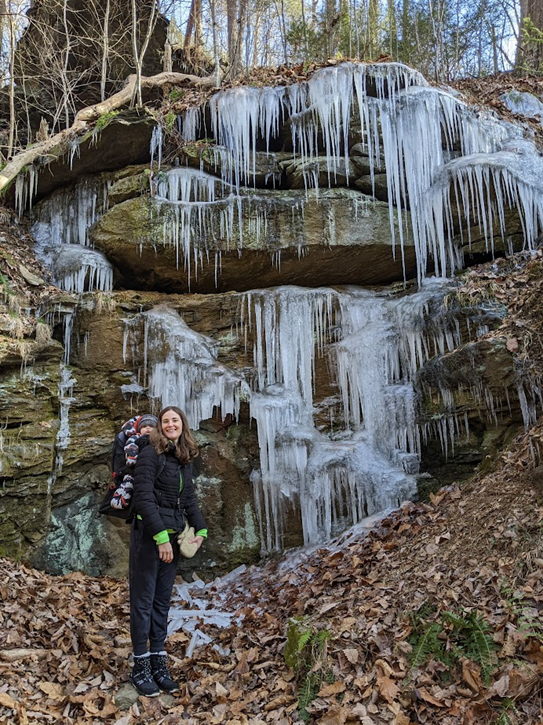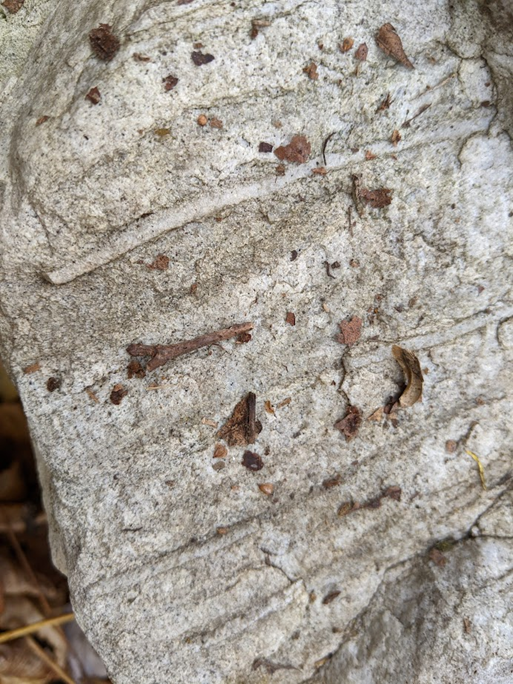By Peggy Eppig, Environmental Educator
Though I miss autumn with its flare and dazzle, at last I can see into the forest and observe the geological structures that make our landscapes so wild and rugged. Winter hiking in many of Lancaster Conservancy’s nature preserves offers great opportunities to observe dramatic formations and landforms that help tell the story of how our landscapes came to be. With the forest canopy down and understory bare, winter is a fantastic time to seek seasonal vistas and stand in the deep valleys, looking up through cliff walls from a steep creek canyon trail. It’s also time to visit boulder fields and outcrops and discover what secrets have been hiding behind all the greenery.
Otter Creek Nature Preserve
Lower Chanceford Township, York County
Learn More

Mason-Dixon Trail at Otter Creek (Photo by Peggy Eppig)
One of my favorite winter hikes is one we did recently as a group of Lancaster Conservancy friends and volunteers. A combination of red-blazed preserve trails and the blue-blazed Mason-Dixon Trail loop through and around the Otter Creek valley, where hikers can see impressive bluffs and ridges overhead and underfoot.
My favorite feature of this preserve hike is a section of the Mason-Dixon Trail that traverses a spine of metamorphic schist rock formed from the ancient floor of the Iapetus Ocean, predecessor of the Atlantic. Deformed under intense heat and pressure as two enormous continental plates collided approximately 450 million years ago, this high ridge of schist is about as wide as the trail itself, and hikers must pay attention to their footing as the slopes on either side drop away into steep-sided forested slopes. Schist outcrops are common throughout Otter Creek Nature Preserve and invite closer inspection of how metamorphic processes folded and bent ancient ocean sediments into a wild array of wavy formations. Look carefully at creek-washed schist cobbles for deep red and black nodules of magnetite and garnet.
Fox Hollow Nature Preserve
Conestoga Township, Lancaster County
Learn More

Ice formation at Fox Follow Nature Preserve (Photo by Peggy Eppig)
When you’ve hiked a few of our preserves in winter, it becomes obvious that water is as much a part of the geological process as rock itself. Where there’s a deep, damp ravine and cold temperatures, you come upon some really outstanding ice formations. Be aware and careful though, hiking on or around ice has its hazards for the unwary hiker!
An old trolley line makes for a mostly flat trail along the Pequea (pronounced “peck-way”) Creek through Fox Hollow Nature Preserve, and from this path you can observe several outcrop seepages that form magnificent ice flows. Ice of course is the solid state of water and is, geologically speaking, a mineral! It has a lot of power to transform landscapes with its freeze-thaw-refreeze cycles…and when it comes plowing down the Susquehanna and its tributaries like a bulldozer during deep freeze events and ice-out. Outcrop seepages, however, are where water is flowing slowly between layers of rock from deep inside a ridge or hill. The perfect conditions for ice falls to form is when temperatures drop well below freezing for several days and nights, causing exposed seepages to form into a variety of ice formations: stalactites inside a rock crevasse and icicles from a ledge, ice spikes that point upwards from drip lines, and ice ribbons along the surface of a vertical face.
Robert A. Kinsley Nature Preserve
Hellam Township, York County
Learn More

Skolithos linerais in quartitze at Robert A. Kinsley Nature Preserve (Photo by Peggy Eppig)
With every turn in the trail, Robert A. Kinsley Nature Preserve seems to throw something made of stone into view. The bluffs drop away with bare rock outcrops, and from Buzzards Roost, you can see that you are standing on the backbone of the Chickies formation, a rugged band of quartzite and schists that arcs through York and Lancaster counties. A talus slope of massive quartzite boulders slips away toward a winter view of the Susquehanna River.
Though winter views are great, the talus slope is what catches my attention. I love to look for Skolithos linerais, fossilized burrows and borings of marine worms that lived on these Cambrian beach sands 500 million years ago. You don’t need to scramble down a talus slope, however, as smaller chunks of weathered quartzite can be found throughout the preserve, and with some careful searching, you can find them in abundance under leaf litter and old stream cuts.
In these same hills I have found delicate sheets of mica embedded in quartz and large nodules of magnetite protruding from slabs of metamorphosed sea bottom. There is abundant mica, graphite, biotite, and talc where metaconglomerate schists meet the Chickies quartzite on the southeast rim of the ridge.
If the rocks at Robert A. Kinsley Nature Preserve could talk, they would tell the story of incredible tectonic processes that built mountain ranges, created volcanic island chains, and warped and lifted the floors of oceans and shallow seas. With winter views of the Susquehanna, we can imagine the powerful force of water, ice, and silt slurry carving out the deep canyons of its riverbed, on the way to the Atlantic through storied rock remains of the Iapetus.
